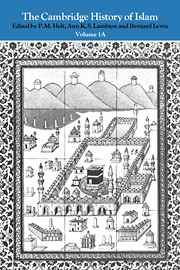Book contents
- Frontmatter
- Introduction
- Part I The rise and domination of the Arabs
- Part II The coming of the steppe peoples
- Part III The central Islamic lands in the Ottoman period
- 1 The rise of the Ottoman empire
- 2 The heyday and decline of the Ottoman empire
- 3 The later Ottoman empire in Rumelia and Anatolia
- 4 The later Ottoman empire in Egypt and the fertile crescent
- 5 Safavid Persia
- 6 Persia: the breakdown of society
- 7 Central Asia from the sixteenth century to the Russian conquests
- Appendix The Golden Horde and its successors
- 8 Tsarist Russia and the Muslims of central Asia
7 - Central Asia from the sixteenth century to the Russian conquests
from Part III - The central Islamic lands in the Ottoman period
Published online by Cambridge University Press: 28 March 2008
- Frontmatter
- Introduction
- Part I The rise and domination of the Arabs
- Part II The coming of the steppe peoples
- Part III The central Islamic lands in the Ottoman period
- 1 The rise of the Ottoman empire
- 2 The heyday and decline of the Ottoman empire
- 3 The later Ottoman empire in Rumelia and Anatolia
- 4 The later Ottoman empire in Egypt and the fertile crescent
- 5 Safavid Persia
- 6 Persia: the breakdown of society
- 7 Central Asia from the sixteenth century to the Russian conquests
- Appendix The Golden Horde and its successors
- 8 Tsarist Russia and the Muslims of central Asia
Summary
The changing situation of central Asia
After the formation of the three great Islamic empires of the Ottomans, the Safavids and the Mughals, the situation of Central Asia in the following centuries was determined. After the death of Muhammad Shaybānī in 916/1510 and the expulsion of Babur from Transoxania and Samarqand in 918/1512, it was clearly impossible for the Turks of Central Asia to subjugate the Persian plateau again as they had done in previous centuries. In spite of prolonged molestation by the Turcomans —comparable with that of Poland and Lithuania by the Crimean Tatars in the same centuries—the Safavids were able to hold out and to make Persia into an independent state with its own unique character.
The border area consequently created between Persia and Central Asia on the Oxus and to the south became not only a political frontier but also in equal degree a religious frontier. Transoxania and the greater part of the eastern Persian settlement area—approximately what is now Afghanistan and Tājīkistān—remained Sunnī; Persia became Shī‘ī. Even though there was no complete barrier against the spread of Persian culture into Central Asia in the following centuries, the difference of faith obstructed its diffusion. Persian culture, moulded by native Sunni forces in India just as much as in Transoxania, in general developed independently and without direct connexions with the culture of the Persian plateau. It was no longer feasible simply to take over works of literature, still less of theology, from thence and to make them a model for local productions.
- Type
- Chapter
- Information
- The Cambridge History of Islam , pp. 468 - 494Publisher: Cambridge University PressPrint publication year: 1977
- 2
- Cited by



